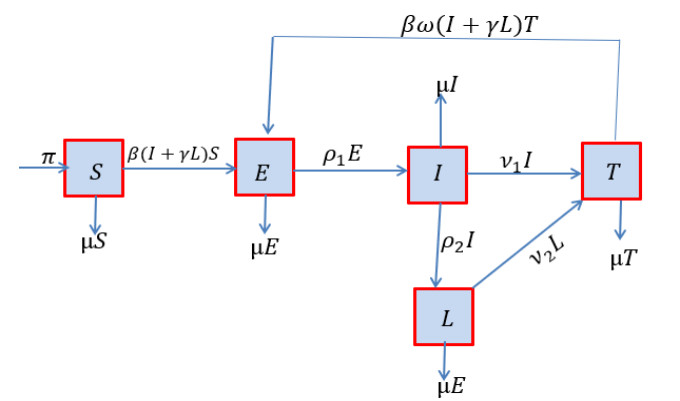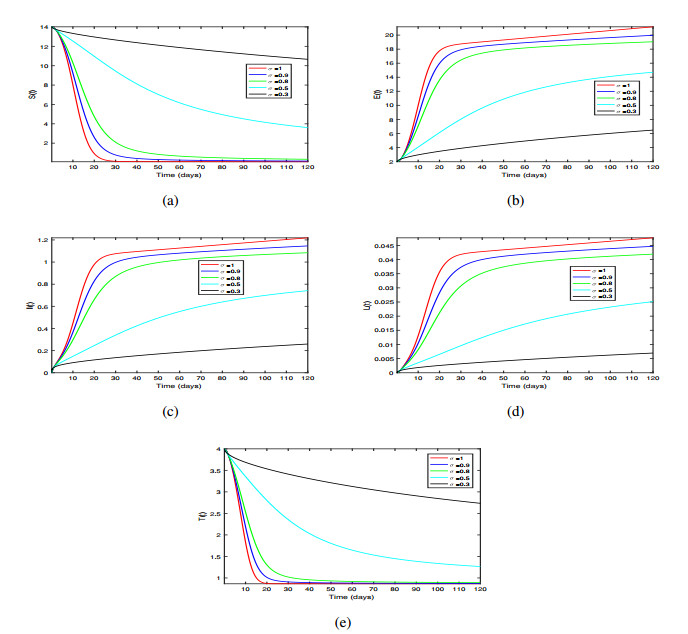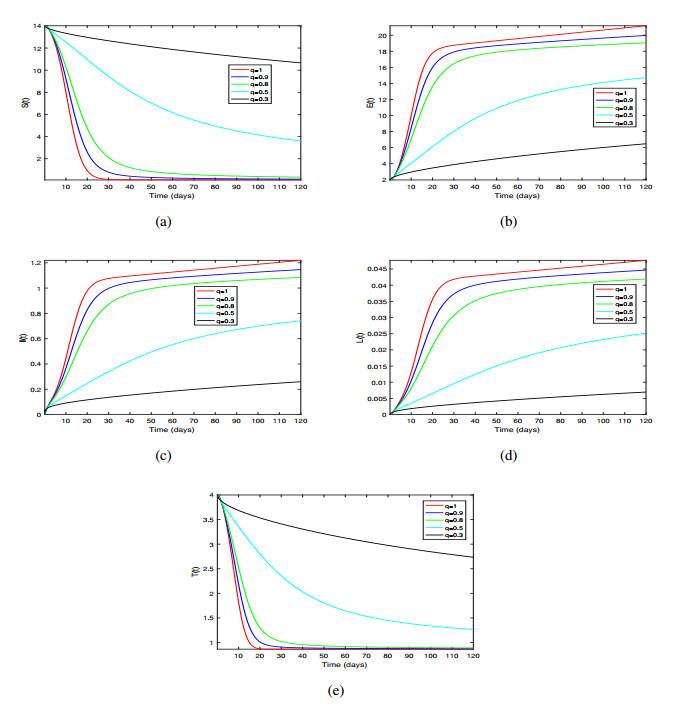1.
Introduction
It is well known that the classical boundary conditions cannot describe certain peculiarities of physical, chemical, or other processes occurring within the domain. In order to overcome this situation, the concept of nonlocal conditions was introduced by Bicadze and Samarskiĭ [1]. These conditions are successfully employed to relate the changes happening at nonlocal positions or segments within the given domain to the values of the unknown function at end points or boundary of the domain. For a detailed account of nonlocal boundary value problems, for example, we refer the reader to the articles [2,3,4,5,6] and the references cited therein.
Computational fluid dynamics (CFD) technique directly deals with the boundary data [7]. In case of fluid flow problems, the assumption of circular cross-section is not justifiable for curved structures. The idea of integral boundary conditions serves as an effective tool to describe the boundary data on arbitrary shaped structures. One can find application of integral boundary conditions in the study of thermal conduction, semiconductor, and hydrodynamic problems [8,9,10]. In fact, there are numerous applications of integral boundary conditions in different disciplines such as chemical engineering, thermoelasticity, underground water flow, population dynamics, etc. [11,12,13]. Also, integral boundary conditions facilitate to regularize ill-posed parabolic backward problems, for example, mathematical models for bacterial self-regularization [14]. Some recent results on boundary value problems with integral boundary conditions can be found in the articles [15,16,17,18,19] and the references cited therein.
The non-uniformities in form of points or sub-segments on the heat sources can be relaxed by using the integro multi-point boundary conditions, which relate the sum of the values of the unknown function (e.g., temperature) at the nonlocal positions (points and sub-segments) and the value of the unknown function over the given domain. Such conditions also find their utility in the diffraction problems when scattering boundary consists of finitely many sub-strips (finitely many edge-scattering problems). For details and applications in engineering problems, for instance, see [20,21,22,23].
The subject of fractional calculus has emerged as an important area of research in view of extensive applications of its tools in scientific and technical disciplines. Examples include neural networks [24,25], immune systems [26], chaotic synchronization [27,28], Quasi-synchronization [29,30], fractional diffusion [31,32,33], financial economics [34], ecology [35], etc. Inspired by the popularity of this branch of mathematical analysis, many researchers turned to it and contributed to its different aspects. In particular, fractional order boundary value problems received considerable attention. For some recent results on fractional differential equations with multi-point and integral boundary conditions, see [36,37]. More recently, in [38,39], the authors analyzed boundary value problems involving Riemann-Liouville and Caputo fractional derivatives respectively. A boundary value problem involving a nonlocal boundary condition characterized by a linear functional was studied in [40]. In a recent paper [41], the existence results for a dual anti-periodic boundary value problem involving nonlinear fractional integro-differential equations were obtained.
On the other hand, fractional differential systems also received considerable attention as such systems appear in the mathematical models associated with physical and engineering processes [42,43,44,45,46]. For theoretical development of such systems, for instance, see the articles [47,48,49,50,51,52].
Motivated by aforementioned applications of nonlocal integral boundary conditions and fractional differential systems, in this paper, we study a nonlinear mixed-order coupled fractional differential system equipped with a new set of nonlocal multi-point integral boundary conditions on an arbitrary domain given by
where cDχ is Caputo fractional derivative of order χ∈{ξ,ζ},φ,ψ:[a,b]×R×R→R are given functions, p,q,δi,x0,y0∈R,i=1,2,…,m.
Here we emphasize that the novelty of the present work lies in the fact that we introduce a coupled system of fractional differential equations of different orders on an arbitrary domain equipped with coupled nonlocal multi-point integral boundary conditions. It is imperative to notice that much of the work related to the coupled systems of fractional differential equations deals with the fixed domain. Thus our results are more general and contribute significantly to the existing literature on the topic. Moreover, several new results appear as special cases of the work obtained in this paper.
We organize the rest of the paper as follows. In Section 2, we present some basic concepts of fractional calculus and solve the linear version of the problem (1.1). Section 3 contains the main results. Examples illustrating the obtained results are presented in Section 4. Section 5 contains the details of a variant problem. The paper concludes with some interesting observations.
2.
Preliminaries
Let us recall some definitions from fractional calculus related to our study [53].
Definition 2.1. The Riemann–Liouville fractional integral of order α∈R (α>0) for a locally integrable real-valued function ϱ of order α∈R, denoted by Iαa+ϱ, is defined as
where Γ denotes the Euler gamma function.
Definition 2.2. The Riemann–Liouville fractional derivative Dαa+ϱ of order α∈]m−1,m],m∈N is defined as
while the Caputo fractional derivative cDαa+u is defined as
for ϱ,ϱ(m)∈L1[a,b].
Remark 2.1. The Caputo fractional derivative cDαa+ϱ is also defined as
In the following lemma, we obtain the integral solution of the linear variant of the problem (1.1).
Lemma 2.1. Let Φ,Ψ∈C([a,b],R). Then the unique solution of the system
is given by a pair of integral equations
where
and it is assumed that
Proof. Applying the integral operators Iξa+ and Iζa+ respectively on the first and second fractional differential equations in (2.1), we obtain
where ci∈R,i=1,2,3 are arbitrary constants. Using the condition y(a)=0 in (2.6), we get c2=0. Making use of the conditions px(a)+qy(b)=y0+x0∫ba(x(s)+y(s))ds and y′(b)=∑mi=1δix(σi)+λ∫bτx(s)ds in (2.6) after inserting c2=0 in it leads to the following system of equations in the unknown constants c1 and c3:
Solving (2.7) and (2.8) for c1 and c3 and using the notation (2.5), we find that
Inserting the values of c1,c2, and c3 in (2.6) leads to the solution (2.2) and (2.3). One can obtain the converse of the lemma by direct computation. This completes the proof.
3.
Main results
Let X=C([a,b],R) be a Banach space endowed with the norm ‖x‖=sup{|x(t)|,t∈[a,b]}.
In view of Lemma 2.1, we define an operator T:X×X→X by:
where (X×X,‖(x,y)‖) is a Banach space equipped with norm ‖(x,y)‖=‖x‖+‖y‖,x,y∈X,
For computational convenience we put:
Our first existence result for the system (1.1) relies on Leray-Schauder alternative [54].
Theorem 3.1. Assume that:
(H1)φ,ψ:[a,b]×R×R→R are continuous functions and there exist real constants ki,γi≥0,(i=1,2) and k0>0,γ0>0 such that ∀x,y∈R,
Then there exists at least one solution for the system (1.1) on [a,b] if
where Li,Mi,i=1,2 are given by (3.1).
Proof. Let us note that continuity of the functions φ and ψ implies that of the operator T:X×X→X×X. Next, let Ω⊂X×X be bounded such that
for positive constants K1 and K2. Then for any (x,y)∈Ω, we have
which implies that
In a similar manner, one can obtain that
In consequence, the operator T is uniformly bounded as
Now we show that T is equicontinuous. Let t1,t2∈[a,b] with t1<t2. Then we have
Analogously, we can obtain
From the preceding inequalities, it follows that the operator T(x,y) is equicontinuous. Thus the operator T(x,y) is completely continuous.
Finally, we consider the set P={(x,y)∈X×X:(x,y)=νT(x,y),0≤ν≤1} and show that it is bounded.
Let (x,y)∈P with (x,y)=νT(x,y). For any t∈[a,b], we have x(t)=νT1(x,y)(t),y(t)=νT2(x,y)(t). Then by (H1) we have
and
In consequence of the above inequalities, we deduce that
and
which imply that
Thus
where M0=min{1−[(L1+L2)k1+(M1+M2)γ1],1−[(L1+L2)k2+(M1+M2)γ2]}. Hence the set P is bounded. As the hypothesis of Leray-Schauder alternative [54] is satisfied, we conclude that the operator T has at least one fixed point. Thus the problem (1.1) has at least one solution on [a,b].
By using Banach's contraction mapping principle we prove in the next theorem the existence of a unique solution of the system (1.1).
Theorem 3.2. Assume that:
(H2)φ,ψ:[a,b]×R×R→R are continuous functions and there exist positive constants l1 and l2 such that for all t∈[a,b] and xi,yi∈R,i=1,2, we have
If
where Li,Mi,i=1,2 are given by (3.1) then the system (1.1) has a unique solution on [a,b].
Proof. Define supt∈[a,b]φ(t,0,0)=N1<∞, supt∈[a,b]ψ(t,0,0)=N2<∞ and r>0 such that
Let us first show that TBr⊂Br, where Br={(x,y)∈X×X:‖(x,y)‖≤r}. By the assumption (H2), for (x,y)∈Br,t∈[a,b], we have
Similarly, we can get
Using (3.6) and (3.7), we obtain
Taking the norm of (3.8) for t∈[a,b], we get
Likewise, we can find that
Consequently,
Now, for (x1,y1),(x2,y2)∈X×X and for any t∈[a,b], we get
which implies that
Similarly, we find that
It follows from (3.9) and (3.10) that
From the above inequality, we deduce that T is a contraction. Hence it follows by Banach's fixed point theorem that there exists a unique fixed point for the operator T, which corresponds to a unique solution of problem (1.1) on [a,b]. This completes the proof.
3.1. Example
Consider the following mixed-type coupled fractional differential system
where ξ=3/4,ζ=7/4,p=1/5,q=1/10,x0=1/1000,y0=0,δ1=1/10,δ2=1/100,σ1=5/4,σ2=3/2,τ=7/4,λ=1/10. With the given data, it is found that L1≃3.5495×10−2,L2≃6.5531×10−2,M1≃1.0229,M2≃0.90742.
(1) In order to illustrate Theorem 3.1, we take
It is easy to check that the condition (H1) is satisfied with k0=1/e2,k1=1/8,k2=1/(3e),γ0=2√7,γ1=1/(6e),γ2=1/7. Furthermore, (L1+L2)k1+(M1+M2)γ1≃0.13098<1, and (L1+L2)k2+(M1+M2)γ2≃0.28815<1. Clearly the hypotheses of Theorem 3.1 are satisfied and hence the conclusion of Theorem 3.1 applies to problem (3.11) with φ and ψ given by (3.12).
(2) In order to illustrate Theorem 3.2, we take
which clearly satisfy the condition (H2) with l1=1/(2e) and l2=1/6. Moreover (L1+L2)l1+(M1+M2)l2≃0.3403<1. Thus the hypothesis of Theorem 3.2 holds true and consequently there exists a unique solution of the problem (3.11) with φ and ψ given by (3.13) on [1,2].
4.
A variant problem
In this section, we consider a variant of the problem (1.1) in which the nonlinearities φ and ψ do not depend on x and y respectively. In precise terms, we consider the following problem:
where φ,ψ:[a,b]×R→R are given functions. Now we present the existence and uniqueness results for the problem (4.1). We do not provide the proofs as they are similar to the ones for the problem (1.1).
Theorem 4.1. Assume that ¯φ,¯ψ:[a,b]×R→R are continuous functions and there exist real constants ¯ki,¯γi≥0,(i=0,1) and ¯k0>0,¯γ0>0 such that, ∀x,y∈R,
Then the system (4.1) has at least one solution on [a,b] provided that (M1+M2)¯γ1<1 and (L1+L2)¯k1<1, where L1,M1 and L2,M2 are given by (3.1).
Theorem 4.2. Let ¯φ,¯ψ:[a,b]×R→R be continuous functions and there exist positive constants ¯l1 and ¯l2 such that, for all t∈[a,b] and xi,yi∈R,i=1,2,
If (L1+L2)¯l1+(M1+M2)¯l2<1, where L1,M1 and L2,M2 are given by (3.1) then the system (4.1) has a unique solution on [a,b].
5.
Conclusions
We studied the solvability of a coupled system of nonlinear fractional differential equations of different orders supplemented with a new set of nonlocal multi-point integral boundary conditions on an arbitrary domain by applying the tools of modern functional analysis. We also presented the existence results for a variant of the given problem containing the nonlinearities depending on the cross-variables (unknown functions). Our results are new not only in the given configuration but also yield some new results by specializing the parameters involved in the problems at hand. For example, by taking δi=0,i=1,2,…,m in the obtained results, we obtain the ones associated with the coupled systems of fractional differential equations in (1.1) and (4.1) subject to the boundary conditions:
For λ=0, our results correspond to the boundary conditions of the form:
Furthermore, the methods employed in this paper can be used to solve the systems involving fractional integro-differential equations and multi-term fractional differential equations complemented with the boundary conditions considered in the problem (1.1).
Conflict of interest
All authors declare no conflicts of interest in this paper.
Acknowledgements
This project was funded by the Deanship of Scientific Research (DSR), King Abdulaziz University, Jeddah, Saudi Arabia under grant no. (KEP-PhD-41-130-41). The authors, therefore, acknowledge with thanks DSR technical and financial support. The authors also thank the reviewers for their useful suggestions on our work.
















 DownLoad:
DownLoad: